Is Hanfu Gender-Neutral? Take the Mamian Skirt as an Example

You’ve probably seen lots of women wearing hanfu—take actress Xu Jiao, for example. She wore a wide-belt mamian skirt to the 36th Golden Rooster Awards while promoting the film Be My Family. It was a great way to showcase the elegance of hanfu on such a formal and public occasion.
However, there’s been some confusion lately. Some media outlets have claimed that the mamian skirt isn’t just for women—that men can wear it too. While inclusivity is great, this kind of statement has led to misunderstandings about hanfu.
For instance, China Daily published a “cultural facts” video on its official website suggesting exactly that. Since it’s an international-facing channel, mistakes like this can mislead both local and global audiences.
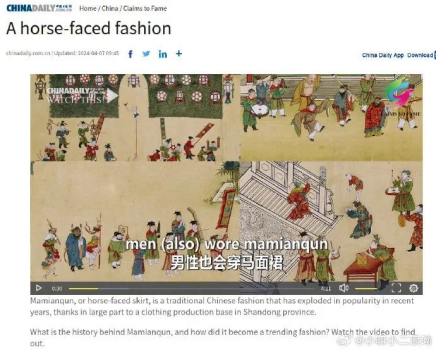
That’s why we made this short video—to help clear things up and offer a simple intro to hanfu for anyone who might be unfamiliar with it. Hopefully, it helps correct some of the common misconceptions.
Ⅰ. The Mamianqun Example
To be honest, hanfu does have men’s and women’s styles—and the mamian skirt is a case in point. It’s probably the most well-known hanfu style, and yes, it’s traditionally a women’s garment. But that doesn’t mean men can’t wear it.
The photos in China Daily’s previous mamian skirt explainer, which showed Ming dynasty men, weren’t actually wearing mamian skirts. Those were yisha robes(曳撒袍) or tieli robes (贴里袍)—totally different.
Scholars like Bao Mingxin and Huang Nengfu note that the term “mamian skirt” historically refers only to women’s styles. This traces back to the Qing dynasty’s “hair-cutting and clothing reform,” which disrupted the original hanfu system. Once worn by both genders, mamian skirts survived only as women’s wear.
Ⅱ. Why Is Men’s Hanfu So Hard to Find?
Let’s go back to the mamianqun for a moment. Just like shirts or jeans today, there are both men’s and women’s versions—same basic structure, but different styling. Women’s skirts usually feature embroidery, decorative hems, and more ornate details. Men’s versions tend to be simpler and more understated, without embroidery or elaborate trims.
Now, we’re definitely not saying that men can’t wear the more decorative styles—they absolutely can if they want to. But it’s worth asking: why is it so difficult to find men’s Hanfu in the first place?
The truth is, there is demand, but many people simply don’t know where to buy men’s Hanfu—especially traditional styles like the male version of the mamianqun.
So where did the confusion come from? Why are people even debating whether men can wear mamianqun?
Part of it comes from the market. Many brands produce “unisex” or couple’s sets to cut costs, blending elements from both men’s and women’s styles, which blurs the lines. On top of that, most people learn about Hanfu from TV dramas or shopping apps—sources that don’t always offer historically accurate information.
Ⅲ. What Did Ancient Men’s Hanfu Actually Look Like?
Traditional men’s Hanfu has a long history. One of the earliest and most formal styles was the “upper garment and lower skirt” system (shang yi xia chang), which dates back thousands of years. Men’s lower garments, or chang (裳), evolved from waist wraps and were an essential part of ceremonial dress in early Chinese civilization.
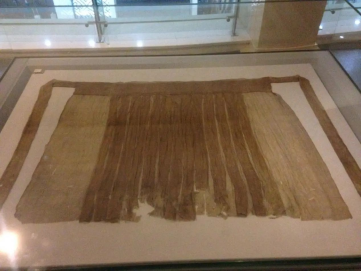
In the Ming Dynasty, both men and women wore skirts with a similar structure—two overlapping panels on each side and pleats sewn into the sides. The women’s mamian skirt followed this format.
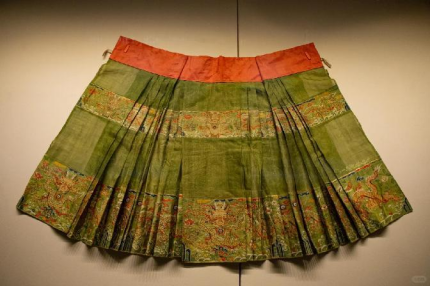
This is men’s version ↓ ↓
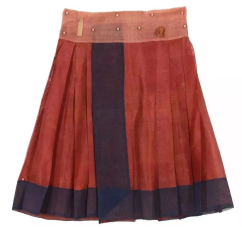
One of the most authoritative examples of male Hanfu comes from a set of court robes once owned by the Confucius family, now featured in the Chinese documentary National Treasure. This complete Ming Dynasty court outfit—believed to be the earliest and best-preserved example—clearly shows the structure and styling of formal men’s Hanfu. ↓ ↓ ↓
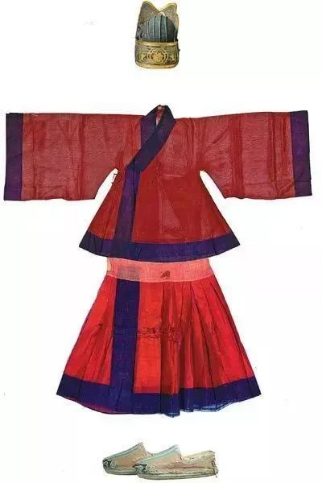
This shows that men’s and women’s lower garments in the Ming Dynasty shared the same structure but differed in style—sound familiar to modern fashion? It’s like Western shirts, which exist for both genders but have totally different cuts and styles, making cross-gender wear uncommon.
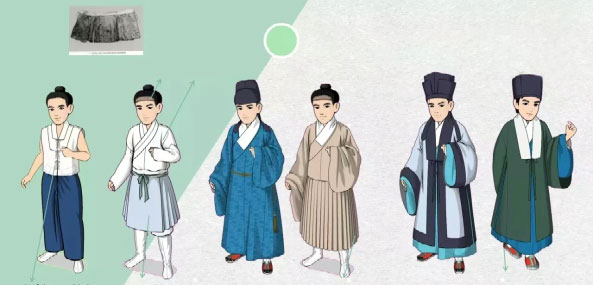
Beyond that, here’s a rough breakdown of men’s typical layering:
- Base layer (the two on the left): A symmetric undershirt or a cross-collar jacket on top, paired with trousers or an underskirt below.
- Middle layer: A daopao (blue) or tieli (beige).
- Outer layer: A changyi (long robe) or a cape.
IV. Some Thoughts
Nowadays in China, men rarely choose to wear robes; their usual outfits are mostly tops with pants. In many cases, men in society are even reluctant to get close to or try hanfu at all—mainly because they find it too cumbersome.
Take a look at the picture below: the man in it is actually wearing a women’s mamian skirt. But what if he thinks he’s dressing up as a “Jinyiwei” (imperial guard agency of the Ming Dynasty)?
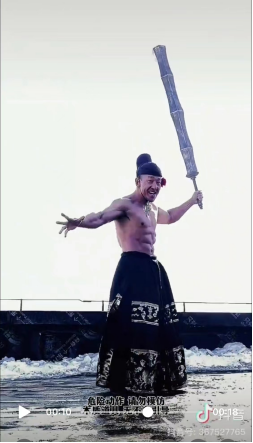
In reality, true Jinyiwei would have worn clothes like yisha robes (曳撒袍) or flying fish robes (飞鱼服).

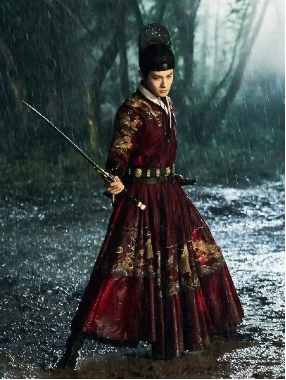
Ⅴ. Which Men’s Hanfu Styles Are Suitable?
Zhiduo (直裰): A cross-collar long coat that falls below the knees, with a clean, smooth silhouette. It has side slits for easy movement, a central seam down the back and front, and sleeves that can be wide or narrow. Perfect for daily outings or casual occasions.
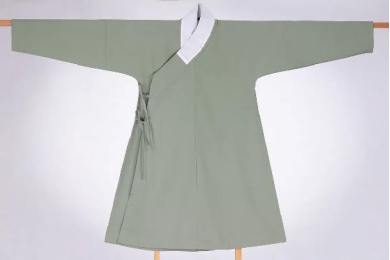
Daopao (道袍): A cross-collar robe with side slits and hidden panels, fastened with ties. It often has a plain white or light-colored collar guard, with wide or straight cuffs. It gives an elegant, scholarly vibe, ideal for daily wear or cultural events.
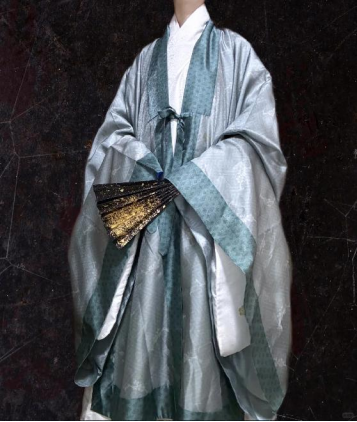
Round-collar robes: Once formal attire for officials, these have a rounded (or “round-collar”) neckline with a stiff inner lining and often buttons. Men’s versions are mostly solid-colored with minimal, simple patterns, making them suitable for daily use or slightly formal occasions.
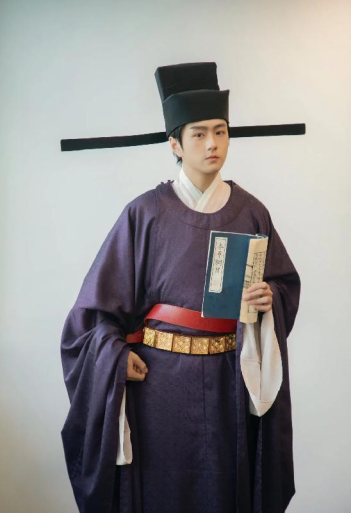
Summary
We believe that much of today’s debate around Hanfu stems from a historical disconnect—a break in cultural continuity that’s left many people unsure about the structure and meaning of traditional clothing. At the heart of it, the issue is simple: most people just haven’t had the chance to really learn what Chinese hanfu is.
That’s why we always encourage newcomers to be patient and open-minded. Rediscovering a cultural tradition as rich and complex as Hanfu takes time—and we’re all still learning together.
No matter your gender, if you wear Hanfu out of respect and appreciation, even if it’s not perfectly “gender accurate,” that’s totally okay. At SilkDivas, we understand. After all, the modern Hanfu industry is still in its early stages.
If you’re curious to learn more about Chinese dress history, styling tips, or cultural insights, feel free to follow us for more bite-sized content and inspiration!
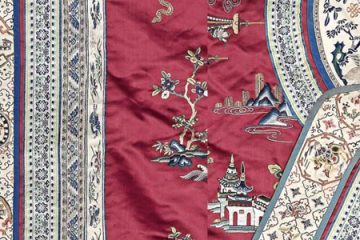
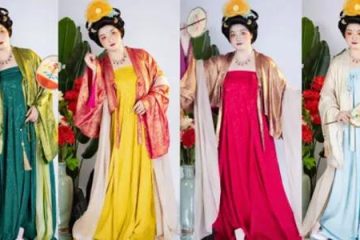
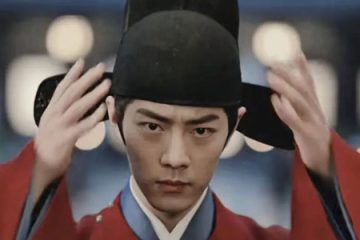
0 Comments